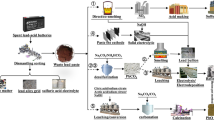Abstract
Korean automobile industry was the fifth largest in the world in 2014, and there was a steady demand for batteries that are essential for automobile production. The battery used in automobile production is a lead acid battery, and since 2010, Korea has been conducting material flow analysis for major industrial-related materials such as lead. Lead material flow had focused on the production of raw and base materials and the battery production, which is one of the intermediate products. Many of these products were exported. Most of the primary leads used in the production of the basic materials were smelted with imported lead ores. Compared to the production capacity of secondary lead companies in Korea, a number of used batteries collected in Korea were insufficient, and the shortages were dependent on imports. 94.7% of the base materials were used for battery production through first processed products as metal, and 5.3% was used as an oxide. In addition, lead is a globally important environmental regulatory substance, and Korea has also managed the recycling of lead acid batteries. 98.2% of the leads collected through recycling process were reintroduced into the base material as the secondary lead.





Similar content being viewed by others
References
Lee IS, Kim JG (2014) Industrial demand and integrated material flow of terbium in Korea. Int J Pr Eng Man Green Technol 1:145–152
Guberman DE (2014) U.S. Geological Survey, Mineral Commodity Summaries, February 2014. 90–91
Guberman DE (2015) U.S. Geological Survey, Mineral Commodity Summaries, February 2015. 90–91
Guberman DE (2011) U.S. Geological Survey, Mineral Commodity Summaries, January 2011. 90–91
Jung MC, Thornton I (1997) Environmental contamination and seasonal variation of metals in soils, plants and waters in the paddy fields around a Pb–Zn mine in Korea. Sci Total Environ 198:105–121
Lee JT, Schwartz J (1999) Reanalysis of the effects of air pollution on daily mortality in Seoul, Korea: a case-crossover design. Environ Health Perspect 107:633–636
Nam DH, Lee DP (2006) Monitoring for Pb and Cd pollution using feral pigeons in rural, urban, and industrial environments of Korea. Sci Total Environ 357:288–295
Zhang W, Yang J, Wu X, Hu Y, Yu W, Wang J, Dong J, Li M, Liang S, Hu J, Kumar RV (2016) A critical review on secondary lead recycling technology and its prospect. Renew Sustain Energy Rev 61:108–122
Timothy WE, Abbas HM (2010) The refining of secondary lead for use in advanced lead-acid batteries. J Power Sources 195:4525–4529
Armand M, Tarascon JM (2008) Building better batteries. Nature 451:652–657
Rabah MA, Barakat MA (2001) Energy saving and pollution control for short rotary furnace in secondary lead smelters. Renew Energy 23:561–577
Fischer P, Maczek H (1982) The present status of development of the QSL lead process. JOM 34:60–64
Deininger L, Choi KC, Siegmund A (1995) Operating experience with the QSL-plants in Germany and Korea. Lurgi corporation
David RW, David AB (2006) Apparent consumption vs. total consumption—a lead-acid battery case study. USGS
Shrivastava P (1995) Environmental technologies and competitive advantage. Strateg Manag J 16:183–200
Maja M, Bodoardo S, Serracane C, Baudino R (1993) Dissolution of pastes in lead-acid battery recycling plants. J Appl Electrochem 23:819–826
Maruthamuthu S, Dhanibabu T, Veluchamy A, Palanichamy S, Subramanian P, Palaniswamy N (2011) Electrokinetic separation of sulphate and lead from sludge of spent lead acid battery. J Hazard Mater 193:188–193
Sun X, Yang J, Zhang W, Zhu X, Hu Y, Yang D, Yuan X, Yu W, Dong J, Wang H, Li L, Kumar RV, Liang S (2014) Lead acetate trihydrate precursor route to synthesize novel ultrafine lead oxide from spent lead acid battery pastes. J Power Sources 269:565–576
Author information
Authors and Affiliations
Corresponding author
Rights and permissions
About this article
Cite this article
Jeong, KP., Kim, J.G. Lead acid battery recycling and material flow analysis of lead in Korea. J Mater Cycles Waste Manag 20, 1348–1354 (2018). https://doi.org/10.1007/s10163-017-0649-6
Received:
Accepted:
Published:
Issue Date:
DOI: https://doi.org/10.1007/s10163-017-0649-6




